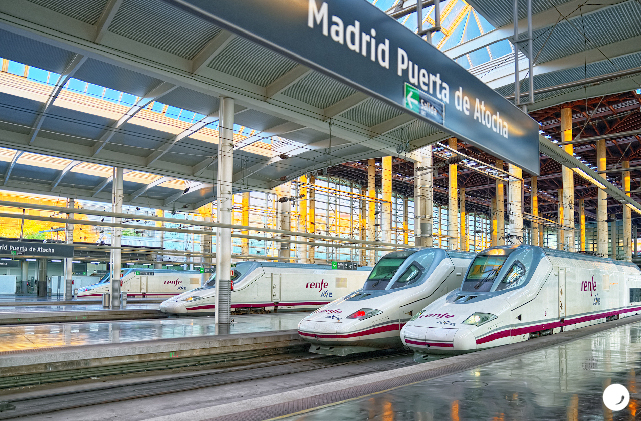History of Madrid Atocha Station
{{imagen_EN}}
Madrid Atocha Station , also known as Madrid Puerta de Atocha, is the main railway station in Madrid , Spain. It was built in 1851 by the State Railway Company and has been enlarged and remodeled several times since then.
The original station was designed by the architect Alberto de Palacio Elissagne, who also participated in the construction of the La Sagrera train station in Barcelona. The original station consisted of a neo-Gothic main building with three levels and a large glass dome that covered the waiting room. The main building had a large glass dome, which allowed natural light into the waiting room, and was decorated with neo-Gothic architectural elements, such as pointed arches, sculptures and frescoes.
In 1892, the station was expanded with the construction of a second building known as the "Estación del Mediodía", which was in charge of suburban and regional trains. This building was connected to the main building by a covered walkway. This second building was built in a simpler and more functional architectural style than the main building, and was used primarily to house the station's service and storage facilities.
During the Spanish Civil War in the 1930s, the station suffered significant damage due to bombing. Despite this, the station continued to operate during the war and was rebuilt after the conflict. However, wartime damage and lack of investment in the station over the following decades resulted in the station becoming an old and dilapidated place.
In 1985, the station underwent a major renovation to accommodate the needs of high-speed trains. The original building was preserved and a new underground station for high-speed trains was built. This redevelopment also included the construction of a shopping center and a subway station in the midday station building.

The 1985 remodeling aimed to make the station a more modern and functional place, as well as a major tourist destination. The main building was converted into a public open space with a tropical garden inside, with palm trees and other tropical plants growing under the glass dome. Shops, restaurants and services for commuters were also built, as well as an underground metro station to connect the station with other parts of the city.
In the years following the remodeling, the Madrid Atocha station became an important connection point for commuter, regional and high-speed trains, as well as for the Madrid metro. In addition, it became an important tourist destination, with a wide variety of shops, restaurants and services, as well as a tropical garden inside the main station building.
However, the station has also suffered some tragic incidents over the years. On December 11, 2017, a terrorist attack at the Atocha station caused the death of 191 people and injured more than 2,000 people. Despite this sad event, the station remained an important connection point for travelers and a popular tourist destination.
In summary, the Madrid Atocha station is a major train station with a long history of construction and refurbishment. Despite the challenges and conflicts it has faced over the years, it has continued to be a vital point for rail transport in Madrid and a popular tourist destination. Although it suffered a sad incident in the past, it is a place that is being remembered for its effort to stay in operation and continue to be an important place for the city of Madrid .
When you go to the Madrid Atocha Station Parking, think about its history and the events that have led to making the airport what it is.
If you like the history and events related to construction works, we also recommend reading:
- The History of Barcelona El Prat Airport
- The History of Madrid Barajas Airport
- The History of Barcelona Sants Station












 " />
" />